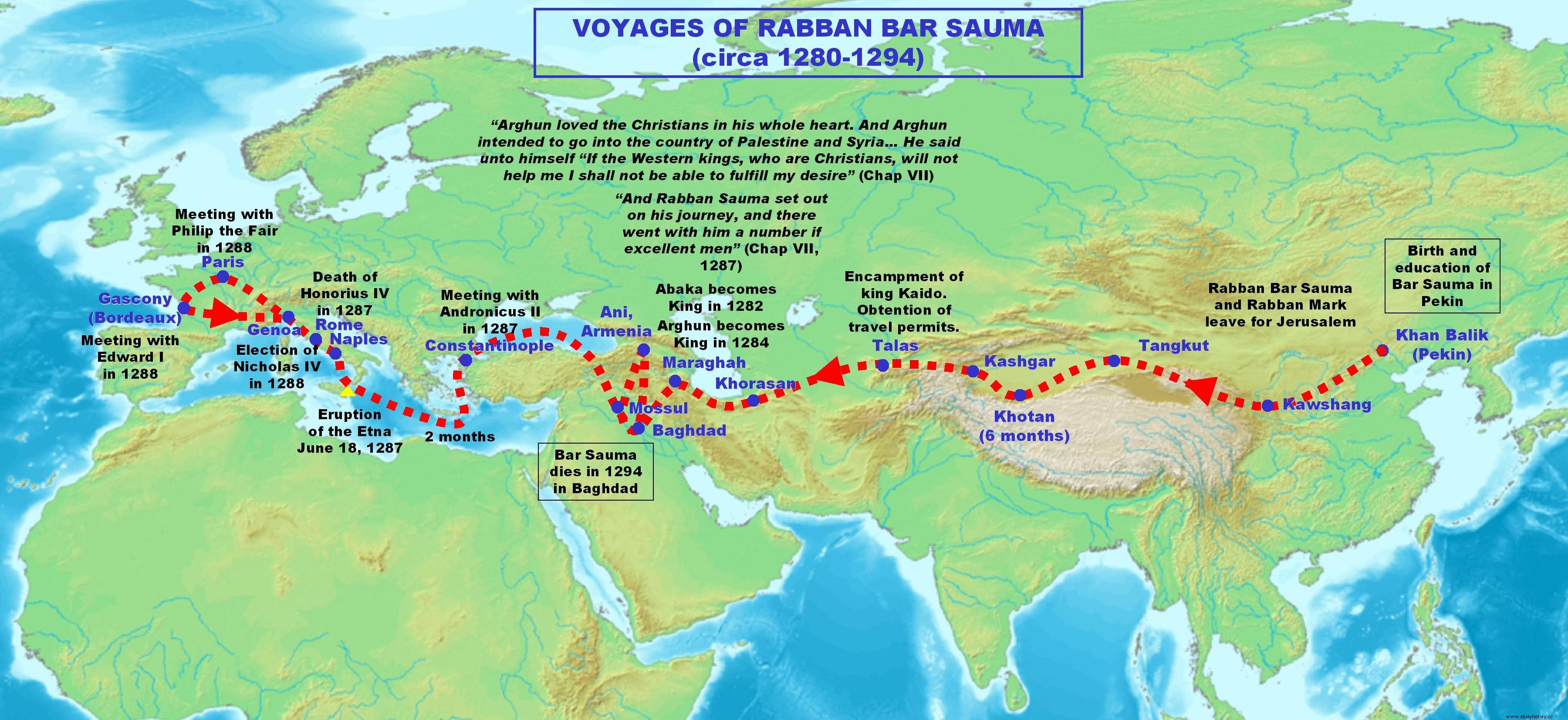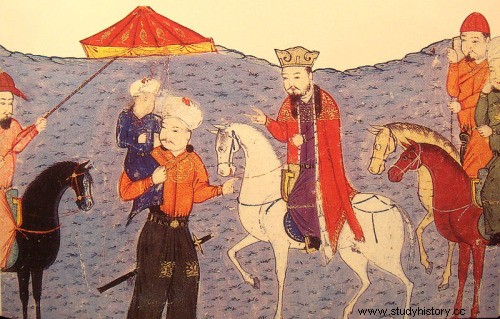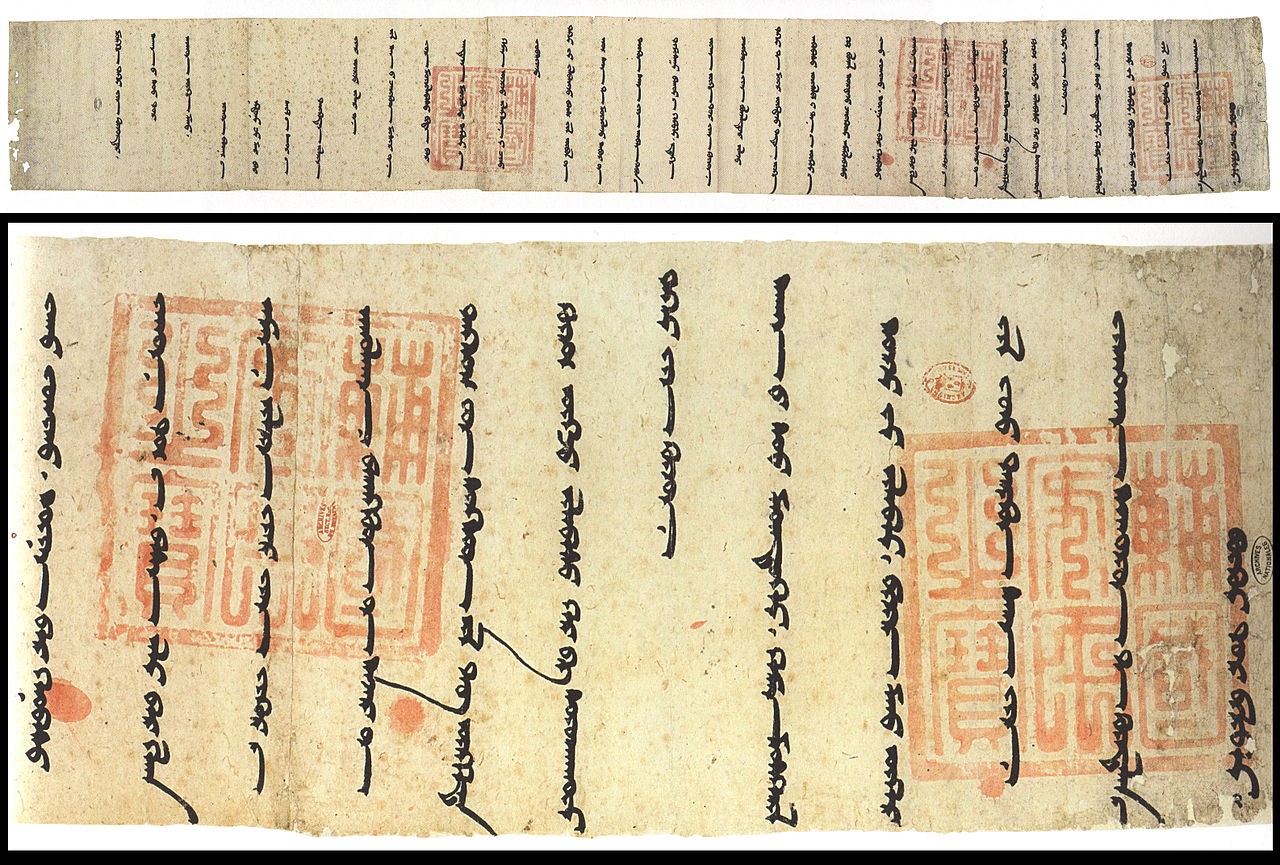Practically at the same time that Marco Polo arrived in China, a Chinese monk of Mongolian origin, Rabban Bar Sauma , he undertook a journey that would end up taking him through Byzantium and medieval Europe and meet emperors, popes and kings. From Mongol-dominated Beijing to Capetian France, Bar Sauma witnessed the eruption of Mount Etna and the election of a pope, met the Emperor of the Byzantine Empire, and forged alliances between the Mongol Empire and the King of France. His fascinating story, recorded in a travel journal, was forgotten for centuries due to the spread of Islam.

Rabban Bar Sauma's Journey
In Kublai Khan's China
Rabban Bar Sauma was born around 1220 in Peking, although then this city was not called that but by its Mongolian name, Khanbaliq , according to Marco Polo «the largest, most beautiful and prosperous city in the world «. It was the capital of the great Mongol Empire, an empire that at that time controlled more than a quarter of the world's population. The Mongols had arrived a few years earlier at Zhongdu , the Chinese capital of the Jin dynasty, destroying it completely. Genghis Khan he had crossed the Great Wall leading an army of one hundred thousand Mongols through the fortified pass of Juyongguan and indeed at this time they had not yet finished their conquest of China, to be completed by Kublai Khan , grandson of Genghis Khan, years later. The fact is that the Great Khan ordered to rebuild Zhongdu and to establish there the capital of the China of the Yuan, the Mongol dynasty:Khanbaliq , "the city of the Khan". In that place and that time was born Bar Sauma, who later, as a Nestorian monk, would acquire the title of Rabban , "Master".
Journey to Jerusalem
Bar Sauma lived as a monk from the age of twenty until, pushed by the wishes of his young disciple Rabban Marcos pilgrimage to the Holy Land and knowing the holy places of Christianity, he undertook the trip to Jerusalem. Imagine what it was like for two ascetic monks in the 13th century to make a journey from Beijing to Jerusalem:more than seven thousand kilometers through Asia skirting the Gobi desert and traversing the Himalayan highlands through the great Ilkhanate , at continuous war with the Golden Horde and the Chagatai Khanate . It was an unprecedented adventure at the time.
However, they had the invaluable help of the caravans that crossed the Silk Road and of Kublai Khan himself, who supported the trip of the two monks with a provision of funds and the necessary safe-conducts. We do not know the exact date of their departure, but we do know that in 1266 they arrived in the Ilkhanate from Persia, where they met the Patriarch of the Church of the East in Baghdad. Interestingly, a few years later, a Venetian merchant, Marco Polo , would travel in the opposite direction to Kublai Khan's court. Both travelers never met. And in Baghdad his journey was so delayed that, when the Patriarch died five years later, Bar Sauma was named his successor. So both monks set off to the court of Abaqa Khan , the governor of the Ilkhanate, to confirm the appointment. A decision that changed his destiny forever, since when he arrived at the Abaqa court he had just died and had been succeeded by his son, Arghun Khan . And the new Ilkan had very different plans for the two monks.
Heading to Europe
Arghun Khan he wanted to establish an alliance between the Ilkhanate and Christian Europe against the common enemy: the Mamluks . And Rabban Bar Sauma was the right person for it:he was a Christian (Nestorian), he spoke Persian, which was a language spoken by the merchants who made the Silk Road, also the Europeans, and he was also a person trusted by the advisers to the Ilkan . And so it was that in 1287 Rabban Bar Sauma undertook a trip to Europe that would lead him to be the first Chinese traveler to set foot in medieval Europe. Accompanied by a small entourage and carrying letters from the Ilkhan of Persia For the Byzantine emperor, the Pope and the kings of France and England, at the age of 67 he crossed Armenia and embarked to cross the Black Sea and reach Constantinople. There he met with the emperor Andronicus II , who expressed good will but no promise of alliance. After a brief visit to the Byzantine capital, where he visited the beautiful basilica of Hagia Sofía, he embarked for Italy to complete the second stage of his trip: meeting with Pope Honorius IV

Rabban Bar Sauma
In Western Europe
His route through the Mediterranean took him to the island of Sicily, where he was when Etna erupted on June 18, 1287. Not only did he witness this event on the island, but six days later he was also able to see the great naval battle in the Bay of Sorrento between the fleets of Charles II of Naples and James II of Aragon, King of Sicily, during the conflict of the Sicilian Vespers . A few days later he landed in Naples and, while on his way to Rome by land, he learned of the death of Pope Honorius IV who had died two months earlier. Even so, he decided to go to Rome, where he arrived in the middle of a plague epidemic, and met with the few cardinals who were in the city for the conclave and who had not died or fled from the disease (the one of 1287-1288 was the deadliest conclave in history, with six of the sixteen electors dead). However, they seemed less interested in his diplomatic mission than in his beliefs (Nestorianism had been declared a heresy in the West in the fifth century, at the Council of Ephesus), and when the debate became tense Bar Sauma changed his speech from monk by diplomat, requesting permission to continue his journey after visiting Rome.
Thus the Nestorian sage continued towards France through the Alps, and as soon as the news reached the ears of Philip IV he sent troops to escort him to Paris, where he met the young king (Philip the Handsome he was then twenty years old) and gave him the gifts sent by the Ilkán, jewels and Persian silks. Felipe IV was young and impetuous, but not stupid, and after receiving Bar Sauma with all the honors and expressing his desire for an alliance with the Ilkhanate, he explained to him the situation in France that forced him to fight to stay on the throne due to the political opposition local, making him see how unwise it would be in his situation to send troops to such distant places and assigned a nobleman to accompany him on his journey back to Mongol territory. Long story short, he too gave up.

Excerpt from Arghun Khan's letter to Philip IV
So again Bar Sauma took up his trip having received very good intentions but without concrete alliances. But before leaving France he went to Gascony, then a fiefdom of the English crown, where he met Edward I in his chateau in Bordeaux. There Eduardo Long Legs he was flattered to receive such a high dignitary... and expressed his impossibility of alliance due to the wars in Wales and the revolts in Scotland. After the refusal of the King of England, Bar Sauma only had the interview with the Pope pending.
After the winter the plague epidemic in Rome had subsided, and the surviving cardinals had elected in conclave the new pope, Nicolas IV , the first Franciscan pope in history. Nicholas IV received Rabban Bar Sauma in Rome in March 1288, delivering a letter to the Ilkan where he expressed his desire to retake the Holy Land... something that unfortunately was not in his hands. The papacy was no longer as strong as it had been a century ago, and Nicholas IV did not have the political power to unite European kings in a Holy Crusade. And so, with promises and wishes but no alliance, Rabban Bar Sauma undertook the trip back to Baghdad empty-handed, after having been the first Eastern diplomat to meet European popes and monarchs.
Death and oblivion
Arghun Khan, however, was satisfied with the outcome of the trip, perhaps hoping that promises of alliance against the Mamluks in the Holy Land would materialize later. That, of course, never happened. The Ilkan died in 1291 without having attacked Jerusalem. Rabban Bar Sauma, for his part, moved to the monastery of Maraghe , in northern Persia, where he spent his remaining years leading a quiet life and writing the account of his wondrous travels. There he died in 1294, at the age of 74, without having returned to his native land.
The consolidation and rise of Islam, however, led to a rapid decline of the Nestorian church in Asia, which practically disappeared during the fourteenth century, mainly due to the genocidal conquests of Timur Lenk, better known in the West as Tamerlane . And the story of Rabban Bar Sauma, the first Chinese traveler in medieval Europe, was forgotten for centuries.
Epilogue
In the 14th century, at the time of Tamerlane's conquests, the patriarch of the Church of the East took refuge with some of his followers in the Hakkari mountains in eastern Anatolia, earning him the name of “Patriarchy of the Mountains ”. There they established their headquarters, founding the small monastic city of Qodshanes . In the small library of Qodshanes, two unique books were found at the end of the 19th century, among the barely sixty volumes that made it up. One of them was the only known surviving copy of the previously missing Liber Heraclidis , written in the 5th century by Nestorio , the bishop of Constantinople who founded the doctrine of Nestorianism, the other was a thirteenth-century autobiographical manuscript of a character forgotten centuries ago. Its title was History of Rabban Bar Sauma .
Collaboration of Enrique Ros of History Notes
